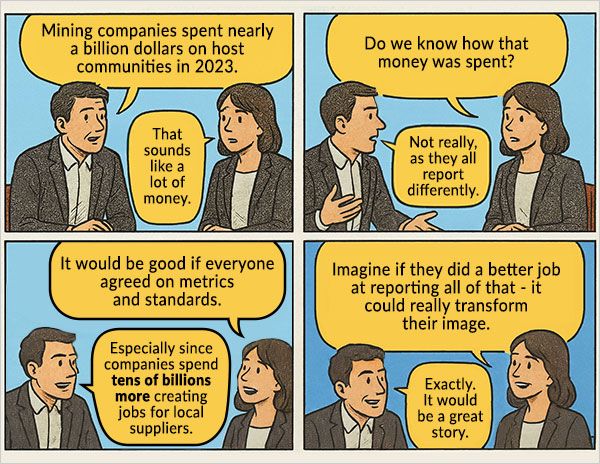
The 2024 annual reports of the largest mining companies listed on western stock markets revealed that they spent close to a billion dollars on host communities – a number that barely makes it into the public consciousness.
This is big money. Spent well, it can have a dramatic impact on its recipients. We got NotebookLM to trawl through the 2024 annual reports of the big 10 mining companies. They all claimed that their long-term success is closely tied to fostering mutually beneficial relationships with the communities and broader society in their operating regions.
First some caveats
Of the 10 companies, six reported their social expenditure in their annual reports (Glencore has a separate report). However, please keep in mind that this exercise is not scientific:
Despite these caveats the reported numbers do give an interesting indication of how much the mining industry spends on host communities. Add in the contribution of other mining companies and you’re probably talking over a billion dollars – though I suspect few could individually match the companies in the table below given their size:
| Expenditure on host mining communities from 2024 annual reports reported by the leading listed mining companies |
| Company | Community Spend (USD million) |
| Anglo American | 145.0 |
| Glencore | 139.0* |
| BHP | 136.7 |
| Rio Tinto | 119.2** |
| Southern Copper | 103.7 |
| Barrick | 48.0 |
| TOTAL | 691.0 |
* This includes expenditure linked to operating payments ** This excludes compensation payments under land access & other legal agreements of $221.9 million |
Many beneficiaries
It’s difficult to tell how many people benefited from these social investments as some mining companies don’t report that data or use terms such as ‘families’, which are made up of more than one individual. Also, there are issues around double counting as individuals may be impacted by several programmes at once. But I suspect it runs into the hundreds of thousands of people benefiting directly and indirectly from this investment.
For example, Southern Copper implemented a water infrastructure improvement project in Mexico touching the lives of 54,000 people and some 10,000 patients were served by a health train that ran near their homes.
To its credit, Anglo-American goes into a lot of detail over how it allocates its social expenditure – so 55% for community development, 20% education and training, 9% for health and welfare and so on.
Tip of the iceberg
However, where these expenditure numbers really balloon is when it comes to how much mining companies spend on buying goods and services from local suppliers and communities. This spend can lead to lots of new jobs and the formation of many new businesses.
Anglo American shelled out $12.1 billion with local suppliers accounting for 88% of its total supplier spend. Barrick spent over $7.1 billion on goods and services from businesses in their host countries (that might not necessarily be local businesses).
Unfortunately, the other mining companies didn’t go into comprehensive detail over how much they spent buying goods and services from local communities and their businesses. Rio Tinto says it spent $31 billion with suppliers globally and seeks to partner with "local and Indigenous businesses where possible"– without breaking down the numbers. Glencore mentions that around 6% of procurement spend for the Brunswick Smelter went to First Nation companies.
What strikes me about going through these reports is the sheer variety of social projects these mining companies are implementing covering health, education, general infrastructure through to economic empowerment schemes.
I’m sure many of them are delivering tremendous value to host communities.
Information gaps
However, I also share the frustrations expressed by some of the institutional investors I’ve spoken with when going through these reports trying to figure out the social performance of these firms. Even though many of these companies adhere to International Council on Mining and Metals standards and UN Sustainable Development Goals – they all have their own governance models and reporting standards.
By contrast, when reporting their financials these companies have to follow strict accounting policies. For instance, over a 100 countries follow International Financial Reporting Standards while the US has its Generally Accepted Accounting Principles. Then there are the governance codes that these companies must follow to foster investor transparency and best practices so investors can trust that these companies are being run properly.
There’s nothing comparable for measuring social performance. Also, few institutional investors and analysts have time to visit individual mines and their adjacent communities to see what’s really happening on the ground. I know from these discussions that this lack of independent verification leaves many of these investors to speculate over whether the information in these annual reports properly reflects reality. Many suspect that they don’t.
These kinds of knowledge gaps can add to the case for an investor deciding not to commit to a mining company (just to be on the safe side by avoiding any potential bad actors).
A great opportunity?
If the mining industry could get its act together by publishing its social data according to well understood credible metrics, for the sake of quality and comparability, it would have a really compelling story to tell the world about the benefits it brings to many poor and struggling communities. Importantly, it would be able to demonstrate those benefits.
If you throw in how much they spend on local labour, services and goods the numbers would swell into tens of billions of dollars making it an even more compelling story.
Elevating the significance and credibility of these numbers could do wonders for the mining industry’s image in the wider world.
